
Полезные материалы за все 6 курсов / Учебники, методички, pdf / INBDEBooster Patient Management Notes
.pdf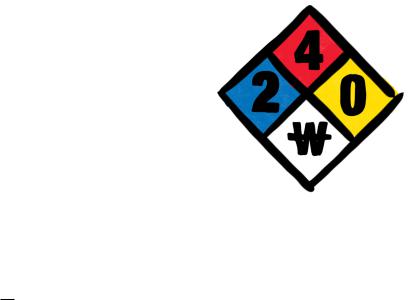
INBDE PATIENT MANAGEMENT NOTES
Examples include rabies,
Microsporum, Leptospira spp. and staphylococci
2.Fomite: form of indirect contact; transmission involving inanimate objects contaminated by an infected individual and can include a wide variety of objects such as exam tables, medical equipment, environmental surfaces, and clothing
Ex: adenovirus, cold sores, hand- foot-mouth disease, and diarrhea
3.Aerosol (Airborne): can occur from breathing, coughing, sneezing, or as a result of dental instruments (see page 10)
4.Oral: can occur from ingesting contaminated food, but more likely in the dental setting, as a result of licking or chewing contaminated surfaces
Ex: Campylobacter, Salmonella, Escherichia coli, and Leptospira
5.Vector-borne: an important route of transmission where pests like mosquitos, fleas, ticks, or rodents persist, and may be brought into the practice
Ex: Lyme disease and Bartonella infection
6.Zoonotic: this mode of transmission may be most prevalent in dental offices that use therapy animals to reduce patient anxiety
Ex: Microsporum, Leptospira, Campylobacter, and Bartonella
Use the mnemonic Da FAVOZ (pronounced: “the favors”) to remember Direct, Fomite, Aersol, Vector-borne, Oral, and Zoonotic
•Workplace safety - all dental offices and clinics are required to comply with the
11
Occupational Safety and Health
Administration (OSHA) Hazard
Communication Standard.
1.Material Safety Data Sheets (MSDSs) made by manufacturer to inform of the handling procedures of common hazardous substances; must be prominently displayed in areas where hazardous substances are stored, used, and disposed
2.The hazardous substances are classified via Category, which is usually a number (1-4) or letter (A, B, C). The higher the number or letter, the greater the hazard the substance is.
The National Fire Prevention Association (NFPA) symbol is a common identifier with blue representing health hazards, red representing flammability hazards, yellow representing instability hazards, and white representing specific hazards
3.Maintain general safety of walking/ working surfaces
4.Available PPE with proper instruction for use and disposal
The EPA is responsible for the management and disposal of dental waste
5.Hazardous communications
INBDE Booster | Booster PrepTM
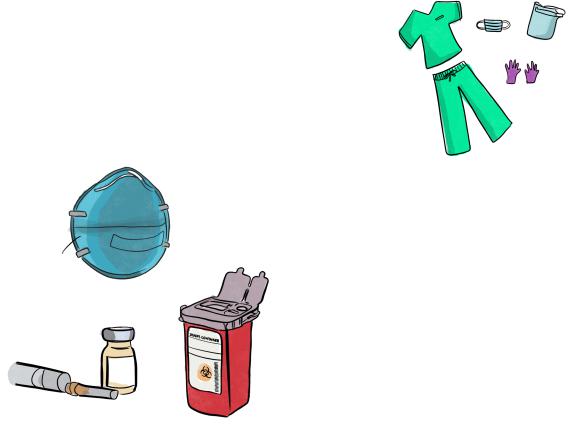
INBDE PATIENT MANAGEMENT NOTES |
12 |
6.Radiation standard: areas that expose individuals to radiation need identifiable caution signs or written labels. Employers must ensure employees are well-versed on correct work procedures for any x-ray machines
7.Bloodborne pathogens standard: written communication of universal precautions, free hepatitis B vaccinations, safe sharp handling, proper labeling of disposal containers, and containment of regulated waste to limit exposure
8.OSHA required paperwork: every dental office must have up-to-date safety plans for general workplace safety, exposure control, chemical inventory, injury or exposure incident reports, records of employee hepatitis B vaccination, and annual employee records of OSHA training sessions
9.Employee education and training: all employees must be fully and appropriately trained for their own safety. This training must happen upon hiring, and must be updated annually to encourage safety and efficiency in the workplace
•Safety in the operatory - specific measures can be taken within the dental operatory to maximize safety in your practice as a whole
1.Noise and vibration safety: the use of dental hand pieces subject dentists to very high amplitudes (>90 dB) and vibration frequencies that can have ill physical, mental, and psychological effects
Recent studies suggest used hand pieces are more hazardous compared to newer ones, and grasping styles must be ergonomic to minimize health effects
2.Dental unit water quality: dental unit waterlines promote bacterial growth and biofilm development. As a result, all units should use systems that treat water to meet drinking water standards (≤ 500 CFU/mL of heterotrophic water bacteria)
3.PPE ensembles: ensure any office staff in the operatory are wearing scrubs/lab coat/smock/gown, gloves, eye protection, and face masks (minimum, surgical mask, ideally, an N95)
Make sure you are changing gloves whenever touching anything contaminated with body fluids, and changing masks in between patients
Ensure in-office laundry units are available to wash any items worn in the office
INBDE Booster | Booster PrepTM
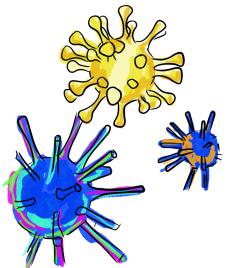
INBDE PATIENT MANAGEMENT NOTES
•Sterilization - destroys everything including all bacteria, viruses, and spores
1.Autoclave/Pressure Sterilization: most common method of sterilization, steam at 121 degrees C at 15 psi for 20-30 minutes
This process utilizes moist heat and pressure to cause denaturation of bacterial proteins and leads to their destruction
Biological indicators (or spore tests) are the best way to monitor sterilization, which work by killing highly resistant microorganisms
2.Glutaraldehyde: sterilizes heat-sensitive items
3.Ethylene oxide (ETO) sterilization: gas penetrates pre-packaged items
4.Dry heat sterilization: used for only glass and metal items, these items are heated at 160 degrees C for 1 hour.
This method causes the coagulation of bacterial proteins and leads to their destruction.
Best technique for minimizing corrosion of sharp items
13
•Disinfection - sprayed and left on nonliving surfaces for 10 minutes. Disinfectants destroys all microbes except for spores.
Mycobacterium tuberculosis is killed by disinfection
•Antisepsis - reduces bacterial numbers on living tissues. The important antiseptics for the dental setting are:
1.Alcohol: most commonly used; is bactericidal, tuberculocidal, fungicidal, and virucidal (does not destroy bacterial spores)
Works by denaturing proteins
2.Quaternary ammonium compounds (QACs): prevent biofilm formation on dental material surfaces, have strong permeability, low toxicity, low skin irritation compared to other antimicrobial agents
Effects the cell membrane integrity of multiple organisms except for TB and endospores
3.Chlorhexidine: can be prescribed or found OTC, this binds tightly to tooth, oral tissues, and dental plaque and ruptures bacterial cell membranes
Shows substantivity, or prolonged association of CHX with substrate (oral mucosa, oral proteins, dental plaque, etc) resulting in a continuous effect
Spaulding classification scheme:
Critical: contacts sterile tissue or vascular system and requires sterilization (ex: needles)
Semi-critical: contacts mucosa and requires high level disinfection (ex: mouth mirror)
Noncritical: contacts skin and requires disinfection (BP cuffs)
INBDE Booster | Booster PrepTM
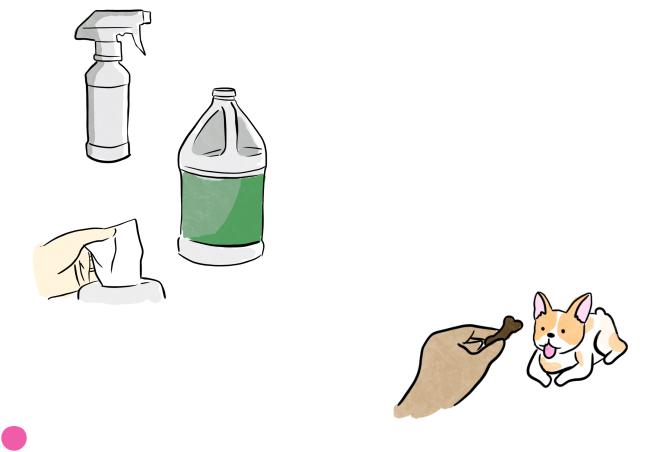
INBDE PATIENT MANAGEMENT NOTES
5 Behavior and Anxiety
For many, going to the dentist is a very anxiety-inducing experience. Understanding the underlying behavioral mechanisms that contribute to this anxiety are essential for the INBDE and are outlined in this section.
•Conditioning - classical (pavlovian) conditioning is the process by which a neutral stimulus is able to directly elicit a response by pairing this stimulus with an unconditioned stimulus that elicits the same response
Operant conditioning, or instrumental conditioning differs in that it is a method of learning the employs rewards and punishments for behavior
-Positive reinforcement: desired action
→reward
-Positive punishment: unwanted action
→punishment
14
-Negative reinforcement: desired action → remove negative stimulus
-Negative punishment: unwanted action → remove positive stimulus
-Classical conditioning comes into play with dental phobias when a negative response is paired with a particular stimulus, whether it be the high-pitched noise of a hand piece, or the particular smell associated with dental offices
•Encouraging behavior change - because of the intense phobias experienced by many individuals, you as a dentist have a unique task of championing for the behavioral changes of your patients to ultimately promote oral health. In order for behavior change to occur in the first place, the COM-B model can be used:
1.Capability: the patient must have the physical or psychological ability to adopt the desired behavior
If you’re trying to help a patient reduce sugary drinks, it is important that you:
Propose a healthier alternative
Help them understand why its important for both oral and overall health to reduce sugar intake
Stay motivated to continue choosing the healthier alternative weeks and months after the appointment
INBDE Booster | Booster PrepTM
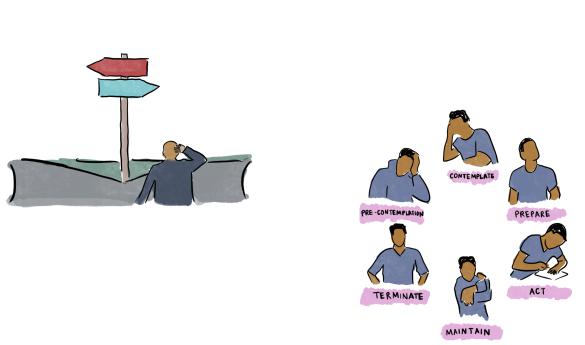
INBDE PATIENT MANAGEMENT NOTES |
15 |
2.Opportunity: the environment, including but not limited to, their income, support-system, and access to different resources can be a major barrier to behavior change
If you’re trying to help a patient reduce cigarette smoking, take into account the following factors:
What stressful experience in the patient’s life might be prompting nicotine use?
Does the patient live or work with smokers?
How can the patient realistically access smoking support (nicotine patches, treatments, etc)?
3.Motivation: the patient must have desire and intention to change or stop habits that might be detrimental to oral and overall health
To motivate a patient to brush regularly, you can help by:
Working with the patient to find times in their personal schedule to brush
Making them aware of the long term impacts of continuing the habit
•The Transtheoretical Model - developed by Prochaska and DiClemente, this model focuses on and illustrates the decision making process.
This cyclical process is important for you to understand and deliver targeted
advice to patients to influence sustained changes in oral health, for example
1.Precontemplation: people are unaware of problematic behavior and underestimate the benefits of changing behavior
2.Contemplation: people recognize that behavior may be problematic, yet still feel apprehensive towards changing behavior
3.Preparation (Determination): people are ready to take action within the next 30 days, and take small steps towards behavior change
4.Action: people have recently changed behavior and intend to carry forward with the behavior change
5.Maintenance: the behavior change has been sustained for more than 6 months, and people work to prevent relapse to previous stages
6.Termination: people no longer have desire to return to unhealthy behaviors
Albeit desirable, note that this is rarely reached, and people tend to stay in the maintenance stage
Most health promotion programs do not include the termination step in their goal-planning for this reason
INBDE Booster | Booster PrepTM

INBDE PATIENT MANAGEMENT NOTES
•Behavioral strategies - there are a number of strategies that you can adopt to help your patient feel more comfortable and receptive to your treatment
1.Motivational interviewing: patientcentered counseling style to assist change from previous ambivalence
OARS: open questions, affirmations, reflective listening, summarizing
Engage: form the relationship
Focus: explore the patient’s motivations, goals, and values
Evoke: elicit own motivations
Plan: explore how the patient can work towards sustained change
2.Establish expectations: let patients know what to expect, give them chances to ask questions, incorporate direct observation (such as allowing children to observe cooperative siblings or parents)
3.Ask-tell-ask:
Ask: about the patient’s feelings towards the visit, and level of knowledge and understanding
Tell: the patient about procedures using easy to understand demonstrations and language
Ask: if the patient understands the treatment and how they feel about it
16
4.Reinforce behaviors: use labeled praise to encourage behaviors you want to see more of
“Great job maintaining the flossing habit!”
Use a positive voice modulation, facial expression, and appropriate physical touch to further reinforce
5.Shaping: reward the successive approximations of a desired behavior
Utilize the reinforcement behaviors to encourage behavior in a step-by-step manner
6.Premack Principle: the act of making a behavior that has a high probability of being performed reliant on a lower probability behavior being performed
•Health Belief Model - a tool used to predict health behaviors based on theory that a person’s willingness to change health behaviors is primarily due to their health perceptions. There are 6 main components:
1.Perceived severity: probability that a person will change their health behaviors to avoid a consequence
2.Perceived susceptibility: people will not change their health behaviors unless they believe they are at a risk
Ex: someone who thinks they will not get the flu is less likely to get an annual flu shot
3.Perceived benefits: people don’t want to give up something they enjoy or their convenience if they don’t get something in return
Ex: a person won’t stop smoking unless they believe that doing so will improve their life
4.Perceived barriers: changing health behaviors can cost money, effort, and time, and common behaviors include:
INBDE Booster | Booster PrepTM
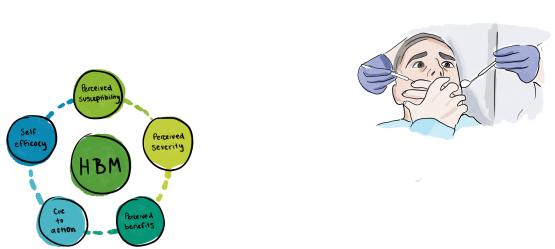
INBDE PATIENT MANAGEMENT NOTES
Danger
Discomfort
Expense
Social consequences
Inconvenience
5.Cues to action: external events that prompt the desire to make a health change
6.Self efficacy: person’s belief in their ability to make a health-related change, and is arguably one of the most important factors in the maintenance of the habit
This model can be used for public health dentistry programs that are used in different settings. Schools may rely on educational programs to enable children to understand importance of oral health. Use of the HBM can provide education, skills training, lowered barriers, and increased self-efficacy.
•Identifying dental anxiety - the initial interaction with the patient can reveal the presence of anxiety
Stress: perceived threat to well-being
Anxiety: subjective experience involving behavioral, cognitive, emotional, and psychological factors
Anxious patients are more likely to sit still, stay quiet, and require more interpersonal distance to be comfortable
17
Anxiety questionnaire: there are several multi-item scales for assessing anxious and phobic patients
Corah’s Dental Anxiety Scale (CDAS): brief, good psychometric properties; drawbacks include no uniformity in answer choices as well as no questions about anxiety regarding local anesthetic injections
Modified Dental Anxiety Scale (MDAS): brief, well-validated 5-point Likert scale responses to assess associated dental fears
Dental Fear Survey (DFS): 20 questions regarding avoidance behavior, psychological fear reactions, somatic symptoms of anxiety, and anxiety caused by dental stimuli
•Managing dental anxiety - there are numerous ways to manage the different levels of dental anxiety:
1.Communication: let patient know what to expect beforehand
Hand signals for breaks, time structuring
2.Behavior management techniques
3.Relaxation techniques: deep breathing, muscle relaxation
Jacobson’s relaxation technique: type of therapy that focuses on tightening and relaxing specific muscle groups in sequence
INBDE Booster | Booster PrepTM
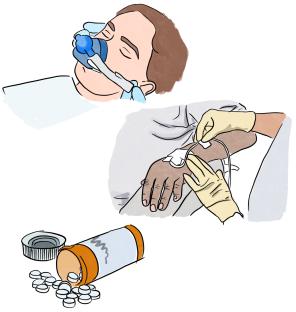
INBDE PATIENT MANAGEMENT NOTES |
18 |
4.Guided imagery: “going to your happy place” via visualization techniques
5.Distraction: incorporate music, tv’s, or even therapy pets to distract patients in your practice
6.Systematic desensitization/graded exposure: expose patients to increasingly feared stimuli while allowing them to pair relaxation responses with the stimuli
7.Habituation: a decrease in response that occurs as a result of repeated or prolonged exposure to conditioned stimuli
8.Rational response/reframing: encouraging thoughts like “I can’t do this” to “I did fine last time”
9.Pharmacological pain management: nitrous oxide, IV sedation, prescription medication
Nitrous oxide: slows down nervous system to reduce inhibitions. Side effects include headaches, shivering, nausea, and sleepiness
IV sedation: you can more accurately titer doses of sedatives that do not affect body processes
-Side effects include headaches, dizziness, and nausea
Prescription medication:
-Diazepam (Valium) has a fast onset of action (20-40 minutes) ,100% oral bioavailability, and doses range from 2-10 mg for adults
-Anxiolytic medications such as temazepam are short-acting small single dose medications taken ~1 before appointments
10.Cognitive appraisal of threat:
Controllability: how controllable the situation appears to be
Familiarity: how familiar the situation is
Predictability: how predictable the situation in
Imminence: is the situation approaching?
11.Child behavior management:
Counting: counting is a significant developmental stage for children, so capitalize on this by incorporating verbal counting into different procedures
Tell-show-do: explain a procedure, show what tools and instruments might be used, and then perform the procedure
Helper: ask the child to help you by sitting in on parent or sibling appointments
Environment: incorporate toys, books, posters in waiting areas or patient rooms
•Dental pain - a complex phenomenon involving emotion and cognition
The Wong-Baker Faces pain scale is a fast and useful assessment tool of pain experiences
INBDE Booster | Booster PrepTM
INBDE PATIENT MANAGEMENT NOTES |
19 |
INBDE Booster | Booster PrepTM
